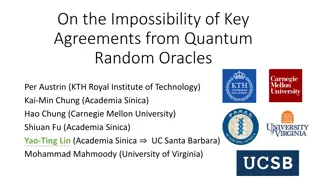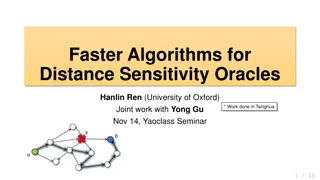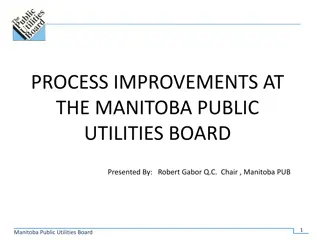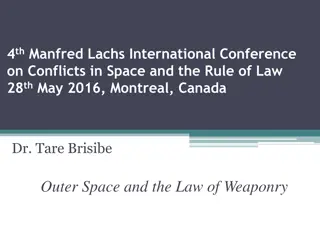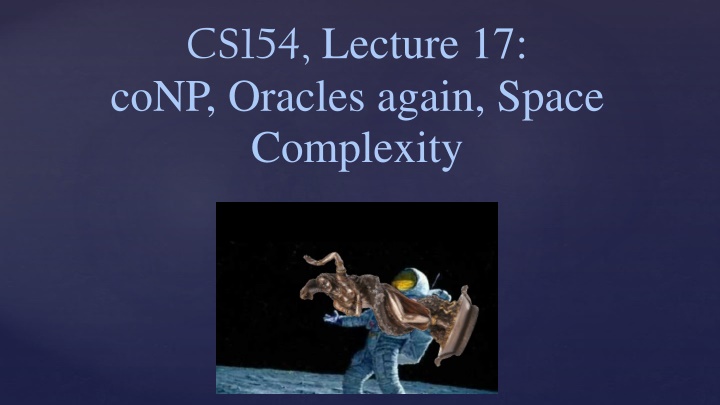
coNP and Space Complexity in Computational Theory
Delve into the concept of coNP in computational theory, exploring how coNP computations differ from NP, discussing the complexity of tautology, P versus coNP, and the relationship between NP and coNP. Learn about coNP-completeness and explore examples like UNSAT and TAUTOLOGY in this comprehensive guide.
Download Presentation

Please find below an Image/Link to download the presentation.
The content on the website is provided AS IS for your information and personal use only. It may not be sold, licensed, or shared on other websites without obtaining consent from the author. If you encounter any issues during the download, it is possible that the publisher has removed the file from their server.
You are allowed to download the files provided on this website for personal or commercial use, subject to the condition that they are used lawfully. All files are the property of their respective owners.
The content on the website is provided AS IS for your information and personal use only. It may not be sold, licensed, or shared on other websites without obtaining consent from the author.
E N D
Presentation Transcript
CS154, Lecture 17: coNP, Oracles again, Space Complexity
Definition: coNP = { L | L NP } What does a coNP computation look like? In NP algorithms, we can use a guess instruction in pseudocode: Guess string y of |x|klength and the machine accepts if some y leads to an accept state In coNP algorithms, we can use a try all instruction: Try all strings y of |x|klength and the machine accepts if every y leads to an accept state
TAUTOLOGY = { | is a Boolean formula and every variable assignment satisfies } Theorem: TAUTOLOGY is in coNP How would we write pseudocode for a coNP machine that decides TAUTOLOGY? How would we write TAUTOLOGY as the complement of some NP language?
Is P coNP? Yes! L P implies that L P (hence L NP) In general, deterministic complexity classes are closed under complement
Is NP = coNP? It is believed that NP coNP
coNP NP P
Definition: A language B is coNP-complete if 1. B coNP 2. For every A in coNP, there is a polynomial-time reduction from A to B (B is coNP-hard)
UNSAT = { | is a Boolean formula and no variable assignment satisfies } Theorem: UNSAT is coNP-complete Proof: UNSAT coNP because UNSAT = SAT (2) UNSAT is coNP-hard: Let A coNP. We show A P UNSAT On input w, transform w into a formula using the Cook- Levin Theorem and an NP machine N for A w A SAT w A SAT w A UNSAT w A UNSAT
UNSAT = { | is a Boolean formula and no variable assignment satisfies } Theorem: UNSAT is coNP-complete TAUTOLOGY = { | is a Boolean formula and every variable assignment satisfies } = { | UNSAT} Theorem: TAUTOLOGY is coNP-complete 1. TAUTOLOGY coNP (already shown) 2. TAUTOLOGY is coNP-hard: UNSAT P TAUTOLOGY: Given formula , output
Every NP-complete problem has a coNP-complete counterpart NP-complete problems: SAT, 3SAT, CLIQUE, VC, SUBSET-SUM, coNP-complete problems: UNSAT, TAUTOLOGY, NOCLIQUE,
coNP ??? NP P
An Interesting Problem in NP coNP FACTORING = { (m, n) | m > n > 1 are integers, there is a prime factor p of m where n p < m } If FACTORING P, then we could break most public-key cryptography currently in use! Theorem: FACTORING NP coNP
To show that FACTORING NP coNP, well use PRIMES = {n| n is a prime integer}
FACTORING = { (m, n) | m, n > 1 are integers, there is a prime factor p of m where n p < m } Theorem: FACTORING NP coNP Proof: The prime factorization p1e1 pkek of m can be used to efficiently prove that either (m,n) is in FACTORING or (m,n) is not in FACTORING: First verify each pi is prime and p1e1 pkek = m If there is a pi n then (m,n) is in FACTORING If for all i, pi < n then (m,n) is not in FACTORING
coNP TAUTOLOGY FACTORING NP P SAT
NP-complete problems: SAT, 3SAT, CLIQUE, VC, SUBSET-SUM, coNP-complete problems: UNSAT, TAUTOLOGY, NOHAMPATH, (NP coNP)-complete problems: Nobody knows if they exist P, NP, coNP can be defined in terms of specific machine models, and for every possible machine we can give an encoding of it. NP coNP is not known to have a corresponding machine model
Polynomial Time With Oracles PNP coNPNPNPNP
How to Think about Oracles? Think in terms of Turing Machine pseudocode or a subroutine An oracle Turing machine M with oracle B * lets you include the following kind of branching instructions: if (z in B) then <do something> else <do something else> where z is some string defined earlier in pseudocode. By definition, the oracle TM can always check the condition (z in B) in one step
Some Complexity Classes With Oracles PB = { L | L can be decided by some polynomial-time TM with an oracle for B } PSAT= the class of languages decidable in polynomial time with an oracle for SAT = the class of languages decidable by some polynomial- time oracle TM with an oracle for some B in NP PNP
Is PSAT PNP? Yes. By definition Is PNP PSAT? Yes: Every NP language can be reduced to SAT! For every poly-time TM M with oracle B NP, we can simulate every query z to oracle B by reducing z to a formula ? in poly-time, then asking an oracle for SAT instead
PB = { L | L can be decided by a polynomial-time TM with an oracle for B } Suppose B is in P. Is PB P? Yes For every poly-time TM M with oracle B P, we can simulate every query z to oracle B by simply running a polynomial-time decider for B. The resulting machine runs in polynomial time
Is NP PNP? Yes Just ask the oracle for the answer! For every L NP define an oracle TM ML which asks the oracle if the input is in L.
Is coNP PNP? Yes! Again, just ask the oracle for the answer! For every L coNP we know L NP Define an oracle TM M L which asks the oracle if the input is in L accept if the answer is no, reject if the answer is yes More generaly, we have PNP = PcoNP
NPB = { L | L can be decided by a polynomial-time nondeterministic TM with an oracle for B } coNPB = { L | L can be decided by a poly-time co-nondeterministic TM with an oracle for B } Is NP = NPNP? Is coNPNP = NPNP? It is believed that the answers are NO
Logic Minimization is in coNPNP Two Boolean formulas and over the variables x1, ,xn are equivalent if they have the same value on every assignment to the variables Are x and x x equivalent? Yes Are x and x x equivalent? No Are (x y) ( x y) and x y equivalent? A Boolean formula is minimal if no smaller formula is equivalent to MIN-FORMULA = { | is minimal} Yes
Theorem: MIN-FORMULA coNPNP Proof: Define NEQUIV = { ( , ) | and are not equivalent} Observation: NEQUIV NP (Why?) Here is a coNPNEQUIV machine for MIN-FORMULA: Given a formula , Try all formulas smaller than : If ( , ) NEQUIV then accept else reject MIN-FORMULA is not known to be in coNP
coNPNP MIN-FORMULA PNP coNP TAUT NPNP P SAT FACTORING NP Decidable Undecidable
Measuring Space Complexity We measure space complexity by looking at the largest tape index reached during the computation
Let M be a deterministic TM. Definition: The space complexity of M is the function ? : , where ?(?) is the largest tape index reached by M on any input of length ?. Definition: SPACE(?(?)) = { L | L is decided by a Turing machine with O(?(?)) space complexity}
Theorem: 3SAT SPACE(n) Proof : Try all possible assignments to the (at most n) variables in a formula of length n. This can be done in O(n) space. Theorem: NTIME(t(n)) is in SPACE(t(n)) Proof : Try all possible computation paths of t(n) steps for an NTM on length-n input. This can be done in O(t(n)) space.
The class SPACE(s(n)) formalizes the class of problems solvable by computers with bounded memory. Fundamental (Unanswered) Question: How does time relate to space, in computing? SPACE(n2) problems could potentially take much longer than n2 steps to solve Intuition: You can re-use space, but not time
Time Complexity of SPACE(S(n)) Let M be a halting TM that on input x, uses S space How many time steps can M(x) possibly take? Is there an upper bound? The number of time steps is at most the total number of possible configurations! (If a configuration repeats, the machine is looping.) A configuration of M specifies a head position, state, and S cells of tape content. The total number of configurations is at most: S |Q| | |S= 2O(S)
Corollary: Space S(n) computations can be decided in 2O(S(n)) time: SPACE(s(n)) TIME(2c s(n)) c N Idea: After 2O(s(n)) time steps, a s(n)-space bounded computation must have repeated a configuration, so then it will never halt
PSPACE = SPACE(nk) k N EXPTIME = TIME(2 ) k N nk PSPACE EXPTIME
Is P PSPACE? YES
Is NP PSPACE? YES
Is NPNP PSPACE? YES
P NP PSPACE EXPTIME Theorem: P EXPTIME Why? The Time Hierarchy Theorem! TIME(2n) P Therefore P EXPTIME
Space Hierarchy Theorem Intuition: If you have more space to work with, then you can solve strictly more problems! Theorem: For functions s, S : N N where s(n)/S(n) 0 SPACE(s(n)) SPACE(S(n)) Proof IDEA: Diagonalization: Make a machine M that uses S(n) space and does the opposite of all s(n) space machines on at least one input So L(M) is in SPACE(S(n)) but not SPACE(s(n))
coNPNP MIN-FORMULA PNP coNP TAUT NPNP P SAT FACTORING NP PSPACE EXPTIME

![Read⚡ebook✔[PDF] Linking the Space Shuttle and Space Stations: Early Docking Te](/thumb/21519/read-ebook-pdf-linking-the-space-shuttle-and-space-stations-early-docking-te.jpg)
![READ⚡[PDF]✔ Emerging Space Powers: The New Space Programs of Asia, the Middle Ea](/thumb/21554/read-pdf-emerging-space-powers-the-new-space-programs-of-asia-the-middle-ea.jpg)







